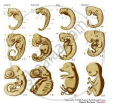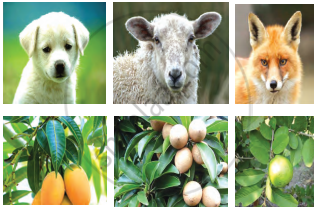Advertisements
Advertisements
प्रश्न
Give a scientific reason.
Morphological evidences suggest that dog, sheep and wolf have a common origin.
उत्तर
The similarities between dog, sheep, and wolves' jaw structures, eye positions, nare structures, and other anatomical features show that these three animals share a common ancestor.
APPEARS IN
संबंधित प्रश्न
Study the following statements:-
I. Wings of birds and wings of bats are homologous organs.
II. Wings of birds and wings of insects are modified forelimbs.
III. Wings of birds and wings of insects are analogous organs.
IV. Wings of birds and forelimbs of horse are homologous organs.
The correct statements are
(A) I and II
(B) II and III
(C) III and IV
(D) I and IV
With the help of any two suitable examples explain the effect of anthropogenic actions on organic evolution.
Which one of the following pairs of vegetables is an example of homologous structures?
(A) Potato and sweet potato
(B) Carrot and radish
(C) Carrot and tomato
(D) Tomato and radish
Attempt giving a clear definition of the term species.
Select and write analogous structures from the list given below :
1) Wings of butterfly and birds
2) Vertebrate hearts
3) Tendrils of Bougainvillea and Cucurbita
4) Tubers of sweet potato and potato
The forelimbs of a frog, a bird and a man show the same basic design (or basic structure) of bones. What name is given to such organs?
The organs which perform different functions but have the same basic structure are known as :
(a) homologous organs
(b) analogous organs
(c) homolytic organs
(d) analytic organs
Wing of an insect and forelimb of a bird are :
(a) analogous organs
(b) analeptic organs
(c) homologous
(d) homophobic organs
The presence of which of the following types of organs in two animals indicates that they are not derived from a common ancestor?
(a) homologous organs
(b) excretory organs
(c) analogous organs
(d) reproductive organs
In a class, students were asked to observe the models/slides/pictures of the skeletons of forelimbs and wings of different organisms. After the observations the students made the following groups of homologous structures. Select the correct group :
(A) Wings of a bird and a butterfly
(B) Wings of a pigeon and a bat
(C) Wings of a butterfly and a bat
(D) Forelimbs of a cow, a duck and a lizard
What do we call the degenerated or partially developed useless organs in living organisms? Enlist such organs in human body? How the same organs are useful in other animals?
Observe the picture and answer the following questions.
A) Which evidence of evolution is shown in the picture?
B) What can be proven with this proof?
C) Give one more example of evidence of evolution
Differentiate between connecting links and the missing links.
Define phylogeny.
I am a connecting link between reptiles and mammals. Who am I?
The decaying process of C-14 occurs continuously in dead organisms only.
Give scientific reason.
Duck-billed platypus shows relationship with mammals.
Define the evidence of evolution shown in the figure.

Observe the given images and answer the following questions.

- Which evolutionary evidence does it indicate?
- What does it prove?
- State another example of evolutionary evidence.
Select the CORRECT match.
Select the CORRECT set of homologous organs.
The fossil remains of Archaeopteryx is a connecting link between ______
Palaeontological evidence for evolution refers to the ______.
Basic principles of embryonic development were pronounced by:
The presence of gill slits, in the embryos of all vertebrates, supports the theory of ______.
What were the characteristics of life forms that had been fossilised?
Did aquatic life forms get fossilised? If, yes where do we come across such fossils?
How do we compute the age of a fossil?
How do we compute the age of a rock?
What is the function of the appendix of our digestive system?
As shown in figure below some organisms that share a common ancestor have features that have different functions, but similar structures.

These are known as ______. Give example.
Write down the difference between homologous and analogous organs.
Write avian characters of Archaeopteryx.
Define the term:
Homologous organs
Give a definition of Palaeontology.
Write names of some vestigial organs in the human body.
